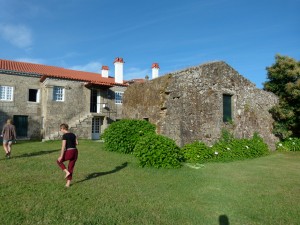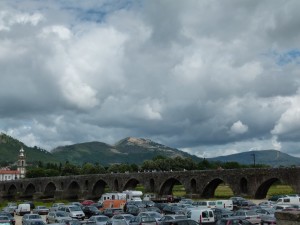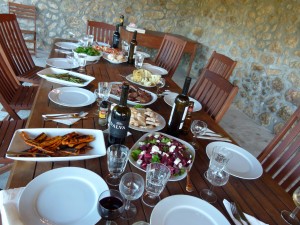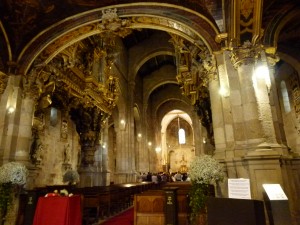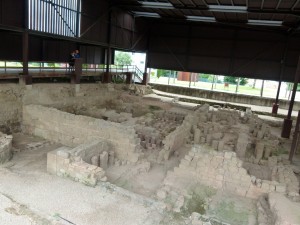Dispatch from Portugal
Posted on July 6, 2014
Geez, the Portaguese countryside is loud. On a Saturday morning by 9 AM we’ve had church bells, firecrackers echoing along the valley (announcing some small town’s saint’s day), a farmer with a weed whacker, and a political candidate traveling these country roads with a loudspeaker. What peace and quiet?
Noise issues aside, we feel like we have found one of last remaining untouristed spots in Europe in the far north of Portugal. The Minho, as this district is called, is lush and agricultural, home to Vino Verde wines and Barrosa cattle and a place where every inch of soil seems to be planted. We’ve rented a lovely old house on a working farm and vineyard, Quinta de Luou.
It’s just a 1.5 kilometers from a tiny hamlet and 8 kilometers from the picturesque Ponte de Lima, with its medieval and Roman stone bridge over the Lima River.
While many Portuguese tourists decend upon Ponte De Lima on the weekends, we have seen almost no English speakers and once outside of town there is little tourism infrastructure.
The only North Americans we’ve met were two Canadians who were hoping to find wine tastings and saw the sign for the house, so knocked on our door. While there is ostensibly a Vino Verde wine trail, there are virtually no open vineyards or tasting rooms such as you’d find in Napa or Tuscany or Burgundy. Since we had purchased bottles of the house Qunita De Luou wine, we cracked open a bottle and gave them an impromptu tasting on the front porch of the house. It’s hard to believe a place so beautiful is not overrun and it confirms our longstanding belief that the wine areas of any country are almost always the most beautiful places to visit.
They always include great food and wine. That said, I wouldn’t put Portuguese cuisine on the top of my best foods list. It’s very meat/cod and potatoes based and the menus vary little from restaurant to restaurant. Hannah, our vegetarian, has struggleed mightily. It’s comfort zone is fish, especially cod. Though in Porto I had to try at least once the local signature sandwich served only there, the Francesinha. It has layers of sausage, ham, and beef with bread, then covered with melted cheese, and sits in a pool of a secret and somewhat spicy red sauce. It’s the kind of thing that should require a cardiologist on site. It’s the kind of meal that easily takes you into the next day.
The wines have been a revelation. This region is famus for Vino Verde, the very young white that has a little effeverecense, a great light summer wine that has become popular in the US. I’m not a huge fan, but the quality of the Vino Verdes here are terrific — largely absent the bubbles and more structured, if still light. The one made here at the house is a favorite and is only 2.5 Euros a bottle. In fact, we are shocked at how low are the food prices. We bought chicken for 12 people and it was only 7.5 Euros (about $10).
Our best meals have been the ones we have cooked at the house, taking advantage of the produce straight from the garden here.
The woman who tends to the garden supplies us with fresh lettuce, onions, spinach, potatoes, parsley, carrots, green beans, and more. The communal cooking, music blaring, followed by dinner outside and conversation and laughter late into the night really are highlights of the trip. With this big house, we have had friends and family coming and going, peaking at 14 and down to 8 this week, a moveable feast.
Yesterday we visited Braga, the charming Medieval city that was the cradle of Christianity in Portugal, It’s Cathedral, started in the 1100s, has been my favorite on this trip and we arrived just in time to see the start of a wedding.
Churches in Spain and Portugal have generally lacked the soaring granduer and amazing windows and play of light that one sees in French cathedrals. They tend to be darker, more foreboding places really, but this one was colorful and warm and ornate. Braga was also an important Roman city, crossroads for five major Roman roads, and we visited the ingenuous Roman baths.
Best of all we found Anjo Verde, a terrific vegetarian restaurant, where I had maybe the best lasagne of my life. I’d go back this week just to have it again.
This is a first visit to Portugal and a culture largely new to me. A couple of observations:
- These are amazingly hard working people. People are constantly tending their gardens and fields, working late into the day, and in this area doing hard backbreaking labor in many instances.
- Their public affect or demeanor is serious. You mght even say unhappy, but as soon as we engage anyone, they are immediately friendly and helpful and smiling. There is not an iota of tourst fatigue or impatience and we’ve found the people to be just lovely.
- Worst drivers any where. No wonder Portugal has some of the highest traffic fatality rates in Europe. Holy cow — tailgating, passing on curves, high speeds on narrow country roads. They make Italian drivers look like the Amish.
- The economic crisis has hit hard here, as was true in Spain as well. Cities like Braga and Porto are full of empty storefronts, for-rent or for-sale signs, and half-empty restaurants. Talking to the staff person at one of the Roman sites, she said many people have left. The cities and towns feel extraordinarily quiet and we keep asking “Where is everyone?” The highways are even oddly empty. In Madrid we saw more people digging through dumpsters and begging, but The Crisis, as it is called here, is still very much shaping day-to-day life.
In this verdant agricultural area, there is much less sense of its impact, as this place never really had the boom and thus little of the bust. Life in this area looks much as it has for hundreds of years, but it is seeing the fastest growth in tourism within the country, Portuguese wines are being lauded iin the NY Times, and we have a sense that we are seeing it in ways that might change greatly in the next ten years.
We had dinner last night in the one boutique hotel in the area, a very hip and eclectic place, and you could see them trying to create the kind of ambience and tone you might find in Napa. But it was also a work in progress, a bit hit or miss, and remains a lonely outpost in a still largely unspoiled area of great beauty. In other words, come now.
